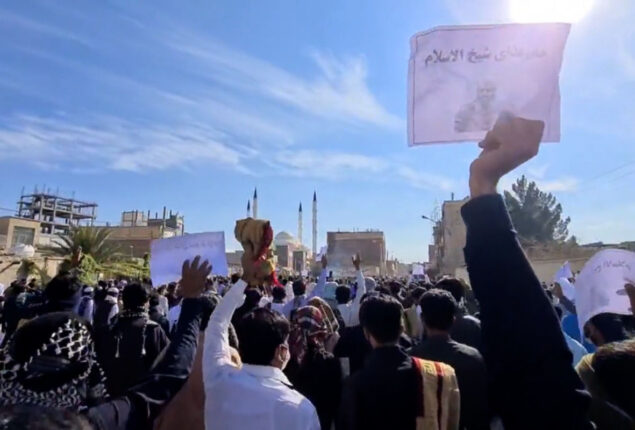Iran: Police shoot at mourners for Mahsa Amini
Mahsa Amini died while in detention after being detained. She reportedly donned...

Iranians marks “Bloody Friday” in southeast flashpoint
As the country’s clerical rulers fought against ongoing widespread unrest, thousands of Iranians demonstrated in the restive southeast on Friday to commemorate a security force crackdown known as “Bloody Friday.”
According to Amnesty International, security forces shot at protesters in Zahedan, the capital of the volatile Sistan-Baluchistan province, in September, killing at least 66 people.
According to the authorities, dissidents started the fights.
According to a video shared by the popular 1500 Tasvir activist Twitter account, hundreds marched in Zahedan on Friday. The video’s veracity could not be confirmed.
Another video, allegedly shot in the southeasterly town of Khash, according to 1500 Tasvir, shows demonstrators trampled and damaged a street sign bearing the name of senior general Qassem Soleimani, who was killed by a US drone attack in Iraq in 2020.
Allegations that a local police officer had raped a teenage girl were the cause of widespread outrage before to the shooting on September 30. The case is under investigation, according to the authorities.
The death of Mahsa Amini, a Kurdish woman who had been imprisoned by morality police for allegedly violating the Islamic Republic’s strict clothing code for women, sparked antigovernmental protests that month as well.
Since then, nationwide protests have evolved into a populist uprising, with participation spanning from students to doctors, attorneys, employees, and athletes, with anger primarily focused at Supreme Leader Ayatollah Ali Khamenei.
A document revealed that a group of nations led by Germany and Iceland asked for a discussion on the “deteriorating” situation in Iran at the top UN human rights council later this month.
The government, which put the blame for Amini’s death on pre-existing medical conditions, has claimed that foreign adversaries of Iran, particularly the United States, are behind the demonstrations and has vowed to restore calm.
Armed separatists are charged with using violence and attempting to topple the Islamic Republic.
The Sistan-Baluchistan and Kurdish regions, which are home to minority ethnic groups with protracted grievances against the state, have seen some of the worst violence.
The Baluch minority, which makes up up to 2 million people, lives in Sistan-Baluchistan, close to Iran’s southeast border with Pakistan and Afghanistan. Human rights organizations claim that they have endured oppression and prejudice for many years. Iran disputes this.
One of the poorest areas of the nation, it has seen attacks on Iranian security forces from Baluch insurgents and has been a flashpoint of unrest.
As of Thursday, 330 protestors had been slain in the turmoil, including 50 juveniles, according to the activist HRANA news agency. According to the report, 39 members of the security forces had also been murdered and approximately 15,100 people had been detained.
A semi-official news source reported on October 31 that the hardline judiciary of Iran will perform public trials for roughly 1,000 persons who were charged with rioting in Tehran.
They were charged with sabotage, attacking or murdering security personnel, and setting fire to government property.
United Nations human rights experts urged Iran’s government in a statement on Friday to avoid charging anyone with crimes that are punishable by death for taking part in or allegedly taking part in peaceful demonstrations.
The special rapporteurs, who are experts, voiced worry that women and girls who have led protests would be specifically targeted.
Videos posted on social media purportedly from the Sistan-Baluchistan town of Saravan showed protesters demanding the death of Khamenei while dressed in traditional Baluch robes.
“Where did the military forces get trained to shoot people? Today it has become clear that people were killed unjustly,” Molavi Abdolhamid, Iran’s most prominent Sunni cleric and a long-time critic of Iran’s Shi’ite leaders, said in his Friday prayer sermon in Zahedan. “Authorities must condemn this crime, and those who ordered (the events of) Bloody Friday and its perpetrators must be brought to trial,” Abdolhamid added.
It seemed like Zahedan’s tensions may flare up once more.
Brigadier General Mohammad Pakpour, the ground forces commander of Iran’s elite Revolutionary Guards, reportedly advised tribal elders and religious leaders from Sunni and Shi’ite communities to exercise caution while speaking out. This was according to state media.
Catch all the World News, Breaking News Event and Latest News Updates on The BOL News
Download The BOL News App to get the Daily News Update & Follow us on Google News.